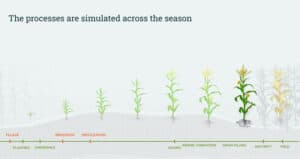Each day, conditions change within the agricultural ecosystem. Crop simulation provides a unique opportunity to track and predict field conditions, crop growth, and soil quality at each critical moment in a growing season. Simulation uses fundamental laws of nature to model how physical, chemical, and biological processes occur, making it possible to predict what would happen under a nearly infinite number of scenarios.
According to the article Crop modeling for climate change impact and adaptation, “Physiology-based crop simulation models have become a key tool in extrapolating the impact of climate change from limited experimental evidence to broader climatic zones, soil types, crop management regimens, crops and climate change scenarios. While these models are a simplification of the reality, they allow a first assessment of the complexity of climate change impact in agriculture. They are playing an increasingly important role in assisting agriculture to adapt to climate change.”
How CIBO Uses Crop Simulation
With CIBO, users can understand interconnected scenarios that range from weather events to seed and soil quality, to what happens if new management techniques are applied in the field. CIBO’s technology predicts and optimizes crop performance in its agricultural ecosystem – including field, soil, environment, weather, water, and farm management practices – before the first seed is planted. Using our science-based approach to crop modeling and simulation, farmers, investors, buyers or nearly anyone in the ag-ecosystem can explore new opportunities to optimize productivity and sustainability while reducing risk.
Examples of different pieces of agriculture CIBO can simulate
- Crop: growth stage timing, leaf area, biomass, Yield
- Soil Biochemistry: Soil carbon, soil nitrogen, net C change, CO2 evolved
- Water balance: EvapoTranspiration, Transpiration, drought stress
- Nitrogen balance: crop nitrogen uptake, nitrogen leaching, crop nitrogen stress

Figure 1: Crop simulation throughout the growing season
How Crop Modeling is used for Regenerative Agriculture
The CIBO crop model calculates the amount of biomass produced by the crop and the transformation of the biomass into soil organic carbon between a baseline scenario using typical management (e.g. no cover crop, no till) and a regenerative scenario using best management (e.g. with cover crop and tillage). The model calculates soil carbon storages over time for each of these management scenarios. The model outputs are then post-processed together with some additional calculations to estimate the soil carbon gains and CO2 emissions avoidance resulting from the regenerative practices. These gains can be converted into carbon credits for growers and businesses who have done regenerative practices.
This is a scientific holistic approach to the soil carbon cycle that attempts to mimic as closely as possible carbon pathways as it leaves the atmosphere, gets absorbed by the plant, gets added to the soil, gets tilled into the soil, then some of it gets released back into the atmosphere. An advantage of using a systems approach like this is the ability to scale up the assessment of regenerative practices without the need to necessarily take soil samples every time, and assess areas that might otherwise be physically inaccessible.



